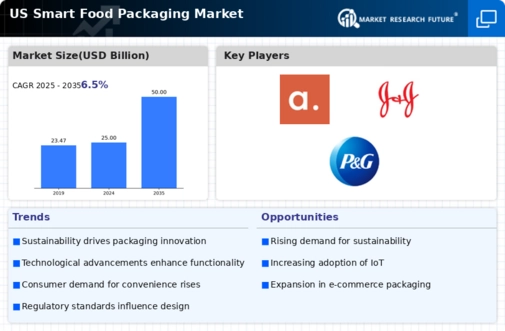Sustainability Initiatives
Sustainability initiatives are becoming a driving force in the smart food-packaging market. With increasing awareness of environmental issues, consumers are gravitating towards eco-friendly packaging solutions. The market is witnessing a shift towards biodegradable and recyclable materials, which aligns with the growing demand for sustainable practices. In 2025, it is estimated that the market for sustainable packaging will account for over 30% of the total smart food-packaging market. Companies are responding by developing innovative materials that reduce environmental impact while maintaining product integrity. This focus on sustainability not only meets consumer expectations but also enhances brand loyalty, thereby contributing to the growth of the smart food-packaging market.
Consumer Demand for Convenience
The growing consumer demand for convenience is significantly influencing the smart food-packaging market. As lifestyles become busier, consumers are increasingly seeking packaging solutions that offer ease of use, such as resealable bags and single-serve portions. This trend is reflected in the market, which is expected to witness a growth rate of 12% annually. Smart packaging technologies, such as temperature indicators and freshness sensors, cater to this demand by providing consumers with information about product quality at a glance. Consequently, manufacturers are investing in innovative packaging designs that not only enhance convenience but also improve the overall consumer experience, thereby propelling the smart food-packaging market.
Regulatory Compliance and Food Safety
Regulatory compliance is a critical driver for the smart food-packaging market. In the US, stringent regulations regarding food safety and labeling are compelling manufacturers to adopt smart packaging solutions. The Food and Drug Administration (FDA) mandates that food products must be accurately labeled, and smart packaging can facilitate compliance by providing real-time data on product conditions. This is particularly relevant as the market is projected to grow at a CAGR of 10% through 2027. By utilizing smart packaging, companies can enhance traceability and reduce the risk of foodborne illnesses, which is increasingly important to consumers. Thus, adherence to regulations not only ensures safety but also fosters consumer trust, further driving the smart food-packaging market.
Technological Advancements in Packaging
The smart food-packaging market is experiencing a surge due to rapid technological advancements. Innovations such as RFID tags, QR codes, and NFC technology are enhancing the functionality of packaging. These technologies allow for real-time tracking of food products, ensuring freshness and safety. In 2025, the market for smart packaging technologies is projected to reach approximately $30 billion in the US, indicating a robust growth trajectory. This growth is driven by the increasing demand for transparency in food supply chains and the need for efficient inventory management. As consumers become more health-conscious, the integration of technology in packaging is likely to play a pivotal role in influencing purchasing decisions, thereby propelling the smart food-packaging market forward.
E-commerce Growth and Online Food Delivery
The rise of e-commerce and online food delivery services is a significant driver for the smart food-packaging market. As more consumers opt for online grocery shopping, the need for packaging that ensures product safety during transit has become paramount. The smart food-packaging market is projected to grow by 15% as e-commerce continues to expand. Packaging solutions that incorporate smart technologies, such as tamper-evident seals and moisture control, are increasingly in demand to maintain product quality. This trend is likely to continue as convenience becomes a priority for consumers, further propelling the smart food-packaging market.














Leave a Comment